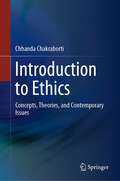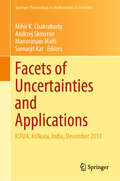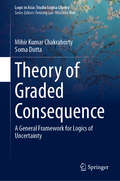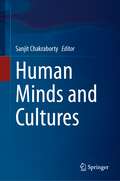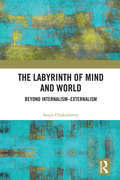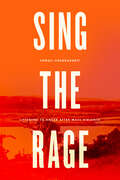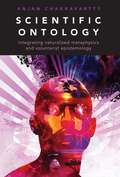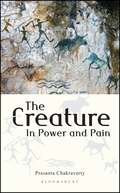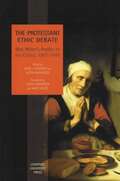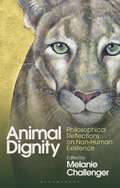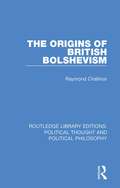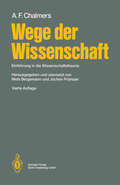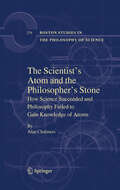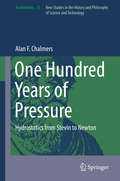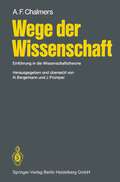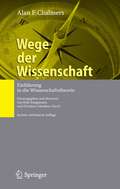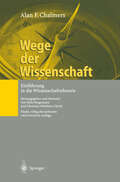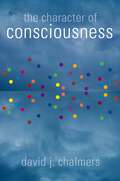- Table View
- List View
Introduction to Ethics: Concepts, Theories, and Contemporary Issues
by Chhanda ChakrabortiThe book introduces the reader to western ethics as a subject, along with its three standard subdivisions. Although the book is written with university students, policymakers, and professionals in mind, the book is lucid enough to be accessible to most adult readers. The book begins with introductions to the basics of ethics. These chapters are meant to provide the reader with the background knowledge necessary for understanding the more technical chapters on metaethics, normative ethics theories, and applied ethics, the three well-known subdivisions within ethics. The chapters that follow take up core ethical issues from each of these areas. The sections focus on explanation and a critical understanding of the ethical issue. The chapters also have examples, cases, and exercises to encourage critical thinking and to enable the reader to grasp the issue better. The book has tried to bring contemporary issues, such as ethics of human organ transplantation, and contemporary theories, such as Amartya Sen’s concept of Justice and Martha Nussbaum’s Capabilities Approach, to engage the readers with ethics in the real world. The book concludes with applied ethics, but with the example of ethics of artificial intelligence. The aim is to keep ethics as a future-driven activity and to emphasize the need to understand the real-world ethical situations and dilemmas that will affect the stakeholders all around the world in the coming years as artificial intelligence and data-driven technologies change our everyday life.
Facets of Uncertainties and Applications: ICFUA, Kolkata, India, December 2013 (Springer Proceedings in Mathematics & Statistics #125)
by Mihir K. Chakraborty Andrzej Skowron Manoranjan Maiti Samarjit KarSince the emergence of the formal concept of probability theory in the seventeenth century, uncertainty has been perceived solely in terms of probability theory. However, this apparently unique link between uncertainty and probability theory has come under investigation a few decades back. Uncertainties are nowadays accepted to be of various kinds. Uncertainty in general could refer to different sense like not certainly known, questionable, problematic, vague, not definite or determined, ambiguous, liable to change, not reliable. In Indian languages, particularly in Sanskrit-based languages, there are other higher levels of uncertainties. It has been shown that several mathematical concepts such as the theory of fuzzy sets, theory of rough sets, evidence theory, possibility theory, theory of complex systems and complex network, theory of fuzzy measures and uncertainty theory can also successfully model uncertainty.
Theory of Graded Consequence: A General Framework for Logics of Uncertainty (Logic in Asia: Studia Logica Library)
by Mihir Kumar Chakraborty Soma DuttaThis book introduces the theory of graded consequence (GCT) and its mathematical formulation. It also compares the notion of graded consequence with other notions of consequence in fuzzy logics, and discusses possible applications of the theory in approximate reasoning and decision-support systems. One of the main points where this book emphasizes on is that GCT maintains the distinction between the three different levels of languages of a logic, namely object language, metalanguage and metametalanguage, and thus avoids the problem of violation of the principle of use and mention; it also shows, gathering evidences from existing fuzzy logics, that the problem of category mistake may arise as a result of not maintaining distinction between levels.
Human Minds and Cultures
by Sanjit ChakrabortyThis book puts forward a harmonious analysis of similarities and differences between two concepts—human minds and cultures—and strives for a multicultural spectrum of philosophical explorations that could assist them in pondering the striking pursuit of envisaging human minds and cultures as an essential appraisal of philosophy and the social sciences. The book hinges on a theoretical understanding of the indispensable liaison between the dichotomy of minds and objectivity residing in semantic-ontological conjectures. The ethnographic sense of cultures confines the scope of cultural scientism, an evolutionary paradigm on the functionalist turn, where one could enthral the cultural phenomenon from the contentment of the conflict of scientific quandaries. Hence, cultural relativism concedes that cultures have some descriptive contents, like customs, beliefs, moral codes, other minds, etc., that are followed by an individual or a group of people. However, the notion of societalsemiotics embarks on the ‘semiotic conception of culture’ that deploys modernity and values centred on ethical conjectures. Human Minds and Cultures conspicuously attune the cultural edifice of moral minds and cope with the enduring prospects of ethics, genders, laws, and socio-political affairs. Essential reading for anyone with a sparkling interest in human minds and cultures.
The Labyrinth of Mind and World: Beyond Internalism–Externalism
by Sanjit ChakrabortyThis book carries forward the discourse on the mind’s engagement with the world. It reviews the semantic and metaphysical debates around internalism and externalism, the location of content and the indeterminacy of meaning in language. The volume analyzes the writings of Jackson, Chomsky, Putnam, Quine, Bilgrami and others, to reconcile opposing theories of language and the mind. It ventures into Cartesian ontology and Fregean semantics to understand how mental content becomes world-oriented in our linguistic communication. Further, the author explores the liaison between the mind and the world from the phenomenological perspective, particularly, Husserl’s linguistic turn and Heidegger’s intersubjective entreaty for Dasein. The book conceives of thought as a biological and socio-linguistic product which engages with the mind-world question through the conceptual and causal apparatuses of language. A major intervention in the field of philosophy of language, this book will be useful for scholars and researchers interested in philosophy, phenomenology, epistemology and metaphysics.
The Labyrinth of Mind and World: Beyond Internalism–Externalism
by Sanjit ChakrabortyThis book carries forward the discourse on the mind’s engagement with the world. It reviews the semantic and metaphysical debates around internalism and externalism, the location of content and the indeterminacy of meaning in language. The volume analyzes the writings of Jackson, Chomsky, Putnam, Quine, Bilgrami and others, to reconcile opposing theories of language and the mind. It ventures into Cartesian ontology and Fregean semantics to understand how mental content becomes world-oriented in our linguistic communication. Further, the author explores the liaison between the mind and the world from the phenomenological perspective, particularly, Husserl’s linguistic turn and Heidegger’s intersubjective entreaty for Dasein. The book conceives of thought as a biological and socio-linguistic product which engages with the mind-world question through the conceptual and causal apparatuses of language. A major intervention in the field of philosophy of language, this book will be useful for scholars and researchers interested in philosophy, phenomenology, epistemology and metaphysics.
Sing the Rage: Listening to Anger after Mass Violence
by Sonali ChakravartiWhat is the relationship between anger and justice, especially when so much of our moral education has taught us to value the impartial spectator, the cold distance of reason? In Sing the Rage, Sonali Chakravarti wrestles with this question through a careful look at the emotionally charged South African Truth and Reconciliation Commission, which from 1996 to 1998 saw, day after day, individuals taking the stand to speak—to cry, scream, and wail—about the atrocities of apartheid. Uncomfortable and surprising, these public emotional displays, she argues, proved to be of immense value, vital to the success of transitional justice and future political possibilities. Chakravarti takes up the issue from Adam Smith and Hannah Arendt, who famously understood both the dangers of anger in politics and the costs of its exclusion. Building on their perspectives, she argues that the expression and reception of anger reveal truths otherwise unavailable to us about the emerging political order, the obstacles to full civic participation, and indeed the limits—the frontiers—of political life altogether. Most important, anger and the development of skills needed to truly listen to it foster trust among citizens and recognition of shared dignity and worth. An urgent work of political philosophy in an era of continued revolution, Sing the Rage offers a clear understanding of one of our most volatile—and important—political responses.
Sing the Rage: Listening to Anger after Mass Violence
by Sonali ChakravartiWhat is the relationship between anger and justice, especially when so much of our moral education has taught us to value the impartial spectator, the cold distance of reason? In Sing the Rage, Sonali Chakravarti wrestles with this question through a careful look at the emotionally charged South African Truth and Reconciliation Commission, which from 1996 to 1998 saw, day after day, individuals taking the stand to speak—to cry, scream, and wail—about the atrocities of apartheid. Uncomfortable and surprising, these public emotional displays, she argues, proved to be of immense value, vital to the success of transitional justice and future political possibilities. Chakravarti takes up the issue from Adam Smith and Hannah Arendt, who famously understood both the dangers of anger in politics and the costs of its exclusion. Building on their perspectives, she argues that the expression and reception of anger reveal truths otherwise unavailable to us about the emerging political order, the obstacles to full civic participation, and indeed the limits—the frontiers—of political life altogether. Most important, anger and the development of skills needed to truly listen to it foster trust among citizens and recognition of shared dignity and worth. An urgent work of political philosophy in an era of continued revolution, Sing the Rage offers a clear understanding of one of our most volatile—and important—political responses.
Sing the Rage: Listening to Anger after Mass Violence
by Sonali ChakravartiWhat is the relationship between anger and justice, especially when so much of our moral education has taught us to value the impartial spectator, the cold distance of reason? In Sing the Rage, Sonali Chakravarti wrestles with this question through a careful look at the emotionally charged South African Truth and Reconciliation Commission, which from 1996 to 1998 saw, day after day, individuals taking the stand to speak—to cry, scream, and wail—about the atrocities of apartheid. Uncomfortable and surprising, these public emotional displays, she argues, proved to be of immense value, vital to the success of transitional justice and future political possibilities. Chakravarti takes up the issue from Adam Smith and Hannah Arendt, who famously understood both the dangers of anger in politics and the costs of its exclusion. Building on their perspectives, she argues that the expression and reception of anger reveal truths otherwise unavailable to us about the emerging political order, the obstacles to full civic participation, and indeed the limits—the frontiers—of political life altogether. Most important, anger and the development of skills needed to truly listen to it foster trust among citizens and recognition of shared dignity and worth. An urgent work of political philosophy in an era of continued revolution, Sing the Rage offers a clear understanding of one of our most volatile—and important—political responses.
Sing the Rage: Listening to Anger after Mass Violence
by Sonali ChakravartiWhat is the relationship between anger and justice, especially when so much of our moral education has taught us to value the impartial spectator, the cold distance of reason? In Sing the Rage, Sonali Chakravarti wrestles with this question through a careful look at the emotionally charged South African Truth and Reconciliation Commission, which from 1996 to 1998 saw, day after day, individuals taking the stand to speak—to cry, scream, and wail—about the atrocities of apartheid. Uncomfortable and surprising, these public emotional displays, she argues, proved to be of immense value, vital to the success of transitional justice and future political possibilities. Chakravarti takes up the issue from Adam Smith and Hannah Arendt, who famously understood both the dangers of anger in politics and the costs of its exclusion. Building on their perspectives, she argues that the expression and reception of anger reveal truths otherwise unavailable to us about the emerging political order, the obstacles to full civic participation, and indeed the limits—the frontiers—of political life altogether. Most important, anger and the development of skills needed to truly listen to it foster trust among citizens and recognition of shared dignity and worth. An urgent work of political philosophy in an era of continued revolution, Sing the Rage offers a clear understanding of one of our most volatile—and important—political responses.
Scientific Ontology: Integrating Naturalized Metaphysics and Voluntarist Epistemology (Oxford Studies in Philosophy of Science)
by Anjan ChakravarttyBoth science and philosophy are interested in questions of ontology - questions about what exists and what these things are like. Science and philosophy, however, seem like very different ways of investigating the world, so how should one proceed? Some defer to the sciences, conceived as something apart from philosophy, and others to metaphysics, conceived as something apart from science, for certain kinds of answers. This book contends that these sorts of deference are misconceived. A compelling account of ontology must appreciate the ways in which the sciences incorporate metaphysical assumptions and arguments. At the same time, it must pay careful attention to how observation, experience, and the empirical dimensions of science are related to what may be viewed as defensible philosophical theorizing about ontology. The promise of an effectively naturalized metaphysics is to encourage beliefs that are formed in ways that do justice to scientific theorizing, modeling, and experimentation. But even armed with such a view, there is no one, uniquely rational way to draw lines between domains of ontology that are suitable for belief, and ones in which it would be better to suspend belief instead. In crucial respects, ontology is in the eye of the beholder: it is informed by underlying commitments with implications for the limits of inquiry, which inevitably vary across rational inquirers. As result, the proper scope of ontology is subject to a striking form of voluntary choice, yielding a new and transformative conception of scientific ontology.
Scientific Ontology: Integrating Naturalized Metaphysics and Voluntarist Epistemology (Oxford Studies in Philosophy of Science)
by Anjan ChakravarttyBoth science and philosophy are interested in questions of ontology - questions about what exists and what these things are like. Science and philosophy, however, seem like very different ways of investigating the world, so how should one proceed? Some defer to the sciences, conceived as something apart from philosophy, and others to metaphysics, conceived as something apart from science, for certain kinds of answers. This book contends that these sorts of deference are misconceived. A compelling account of ontology must appreciate the ways in which the sciences incorporate metaphysical assumptions and arguments. At the same time, it must pay careful attention to how observation, experience, and the empirical dimensions of science are related to what may be viewed as defensible philosophical theorizing about ontology. The promise of an effectively naturalized metaphysics is to encourage beliefs that are formed in ways that do justice to scientific theorizing, modeling, and experimentation. But even armed with such a view, there is no one, uniquely rational way to draw lines between domains of ontology that are suitable for belief, and ones in which it would be better to suspend belief instead. In crucial respects, ontology is in the eye of the beholder: it is informed by underlying commitments with implications for the limits of inquiry, which inevitably vary across rational inquirers. As result, the proper scope of ontology is subject to a striking form of voluntary choice, yielding a new and transformative conception of scientific ontology.
The Creature: In Power and Pain
by Prasanta ChakravartyThe Creature is an invitation to follow the mechanics between power and pain, which begets the creature. Creatures confront power in, and through, conjunctures of radical contingency. The casual use of power is an exercise in distraction. It is an abiding conundrum that those who endure affliction also exert it as a force over other living bodies in equal measure-not as acts of vengeance or bad faith, but through deeds of forgetful randomness. To ensure social indemnity and security, creatures exercise force over kindred embodiments through a process of collective mimicry. In the bargain, creatures begin to disfigure and distort each other. The line between mutual slaughter and mutual embrace begins to blur. Each transgresses its own soul. At other times, power is an opaque, magisterial and disdainful style of conveyance. It reveals itself out of nowhere. But the steadfast creature is as resilient as it is vulnerable. The more it endures, the greater its perdurance. Perduring creatures may sometimes gain a second sight, forged out of a sense of lyricality, love and abdication. But is abdication, or taking refuge in the wondrous, sufficient to release all creatures from the fatal loop of power and pain? Or will they have to slowly shed creaturely affliction by a rigorous process of decreation?Sifting through the writings of Giambattista Vico, Niccolò Machiavelli, Gabriel Tarde, Miguel de Unamuno, Jibanananda Das, Lev Shestov, Raymond Geuss, Jean Starobinski, Ernst Bloch, Simone Weil, Simon Critchley, Sarah Kane and others, this volume explores the creaturely predicament and its possibilities of freedom.The five chapters in Book I lay down fundamental questions for the creaturely condition: the question of mimicry, the relationship between taking initiative and being hounded, the bridge between senses and destitution, and the vehemence of radical contingency. Book II posits the question of skepticism, fideism and their connection to resilience and generosity in creatures. Book III is entirely devoted to various ways of conceiving the aesthetic: through the tragic, the epiphanic, the catastrophic and through militant material eruptions. Book II and III essentially delve into the sites of freedom that lurk within the condition of the creaturely. Book IV is constituted of a single chapter on the subject of decreation; it grapples with questions of attention, anonymity and abdication.
The Protestant Ethic Debate: Weber’s Replies to His Critics, 1907-1910 (Studies in Social and Political Thought #3)
by David Chalcraft Austin HarringtonMax Weber’s The Protestant Ethic and the Spirit of Capitalism continues to be one of the most influential texts in the sociology of modern Western societies. Although Weber never produced the further essays with which he intended to extend the study, he did complete four lengthy Replies to reviews of the text by two German historians. Written between 1907 and 1910, the Replies offer a fascinating insight into Weber’s intentions in the original study, and the present volume is the first complete translation of all four Replies in English.
Animal Dignity: Philosophical Reflections on Non-Human Existence
by Melanie ChallengerHow do we understand the dignity and value of non-human animals? Leading philosophers, ethnologists and writers contribute to this interdisciplinary and wide-ranging account of animal dignity. With a foreword by world-leading primatologist, Dr. Jane Goodall DBE, essays collected here make the case for applying the concept of dignity beyond its usual humanist framework and introduce readers to animal dignity in history, law, science, philosophy, and literature. United in recognizing the dignity of non-human animals, these essays suggest how we might ensure a flourishing environment in times of ecological destruction and climate breakdown. Historians, primatologists, philosophers, novelists and artists approach the concept of animal dignity creatively, offering interpretations that are academically rigorous, alongside ones that are personal and literary. This variety of engagement knits together a fruitful way forward for progressive relations between all species.
The Origins of British Bolshevism (Routledge Library Editions: Political Thought and Political Philosophy #13)
by Raymond ChallinorFirst published in 1977. This book describes the growth of revolutionary organisations in Britain from 1900 onwards. It shows that there was an indigenous movement that developed quite independently from the left in other countries, although its basic outlook was remarkably similar to that of the Bolsheviks in Russia. The study concentrates the activities of the Socialist Labour Party, a small group of dedicated revolutionaries, whose impact on working-class politics had not been fully recognised. The most controversial section of the book deals with the Russian influence on the machinations that led to the formation of the British Communist Party. It is critical of Lenin, who sometimes gave advice on the basis of insufficient knowledge, and of Comitern agents, like Theodore Rothstein, with dubious political backgrounds. This title will be of great interest to students of politics, philosophy, and history.
The Origins of British Bolshevism (Routledge Library Editions: Political Thought and Political Philosophy #13)
by Raymond ChallinorFirst published in 1977. This book describes the growth of revolutionary organisations in Britain from 1900 onwards. It shows that there was an indigenous movement that developed quite independently from the left in other countries, although its basic outlook was remarkably similar to that of the Bolsheviks in Russia. The study concentrates the activities of the Socialist Labour Party, a small group of dedicated revolutionaries, whose impact on working-class politics had not been fully recognised. The most controversial section of the book deals with the Russian influence on the machinations that led to the formation of the British Communist Party. It is critical of Lenin, who sometimes gave advice on the basis of insufficient knowledge, and of Comitern agents, like Theodore Rothstein, with dubious political backgrounds. This title will be of great interest to students of politics, philosophy, and history.
Wege der Wissenschaft: Einführung in die Wissenschaftstheorie
by A.F. ChalmersChalmers stellt in einfacher Sprache und anhand vieler Beispiele die Grundlagen der Wissenschaftstheorie sowie die wichtigsten Richtungen dieses Fachgebiets dar. Das Buch setzt keine spezifischen Vorkenntnisse voraus. Dem Autor gelingt es, den Leser an die neuere wissenschaftstheoretische Diskussion heranzuführen. Die Theorien von Karl Popper, Imre Lakatos, Thomas Kuhn und Paul Feyerabend werden einzeln dargestellt und kritisch miteinander verglichen. Die deutsche Ausgabe wurde durch eine aktuelle Bibliographie, zusammenfassende Fragestellungen zu jedem Kapitel sowie durch ein Sachregister ergänzt. Das Buch bietet Studenten und Interessierten aller Fachrichtungen einen Einstieg in die Wissenschaftstheorie, der eine Auseinandersetzung mit den verschiedenen Ansätzen des Gebietes erlaubt.
The Scientist's Atom and the Philosopher's Stone: How Science Succeeded and Philosophy Failed to Gain Knowledge of Atoms (Boston Studies in the Philosophy and History of Science #279)
by Alan ChalmersDrawing on the results of his own scholarly research as well as that of others the author offers, for the first time, a comprehensive and documented history of theories of the atom from Democritus to the twentieth century. This is not history for its own sake. By critically reflecting on the various versions of atomic theories of the past the author is able to grapple with the question of what sets scientific knowledge apart from other kinds of knowledge, philosophical knowledge in particular. He thereby engages historically with issues concerning the nature and status of scientific knowledge that were dealt with in a more abstract way in his What Is This Thing Called Science?, a book that has been a standard text in philosophy of science for three decades and which is available in nineteen languages. Speculations about the fundamental structure of matter from Democritus to the seventeenth-century mechanical philosophers and beyond are construed as categorically distinct from atomic theories amenable to experimental investigation and support and as contributing little to the latter from a historical point of view. The thesis will provoke historians and philosophers of science alike and will require a revision of a range of standard views in the history of science and philosophy. The book is key reading for students and scholars in History and Philosophy of Science and will be instructive for and provide a challenge to philosophers, historians and scientists more generally.
One Hundred Years of Pressure: Hydrostatics from Stevin to Newton (Archimedes #51)
by Alan F. ChalmersThis monograph investigates the development of hydrostatics as a science. In the process, it sheds new light on the nature of science and its origins in the Scientific Revolution. Readers will come to see that the history of hydrostatics reveals subtle ways in which the science of the seventeenth century differed from previous periods. The key, the author argues, is the new insights into the concept of pressure that emerged during the Scientific Revolution. This came about due to contributions from such figures as Simon Stevin, Pascal, Boyle and Newton. The author compares their work with Galileo and Descartes, neither of whom grasped the need for a new conception of pressure. As a result, their contributions to hydrostatics were unproductive. The story ends with Newton insofar as his version of hydrostatics set the subject on its modern course. He articulated a technical notion of pressure that was up to the task. Newton compared the mathematical way in hydrostatics and the experimental way, and sided with the former. The subtleties that lie behind Newton's position throws light on the way in which developments in seventeenth-century science simultaneously involved mathematization and experimentation.This book serves as an example of the degree of conceptual change that new sciences often require. It will be of interest to those involved in the study of history and philosophy of science. It will also appeal to physicists as well as interested general readers.
Wege der Wissenschaft: Einführung in die Wissenschaftstheorie
by Alan F. ChalmersIn der heutigen Zeit genießt Wissenschaft ein hohes Ansehen. An scheinend ist es eine weitverbreitete Annahme, daß es mit der Wissenschaft und ihren Methoden etwas Besonderes auf sich hat. Wenn eine bestimmte Behauptung, ein Gedankengang oder eine Untersuchung als "wissenschaftlich" bezeichnet wird, dann soll damit unterstellt werden, daß sie besonders wertvoll oder zuverlässig sei. Aber wenn die Wissenschaft etwas Besonderes bietet, was ist dann dieses Besondere? Was ist die "wissenschaftliche Methode", die angeblich zu besonders wertvollen oder zuverlässigen Ergebnissen führt? Dieses Buch ist ein Versuch, derartige Fragen zu klären und zu beantworten. Es zeigt sich im Alltagsleben, daß die Wissenschaft ein hohes Ansehen genießt, trotz einiger ernüchternder Konsequenzen, wie die Wasserstoffbombe oder die Umweltverschmutzung, für die sie ver antwortlich gemacht wird. Die Werbung verspricht uns häufig, daß ein bestimmtes Produkt wissenschaftlich nachgewiesen reiner, kräftiger, sexuell anziehender oder in irgendeiner Art und Weise besser als Konkurrenz artikel sei. Dabei wird darauf spekuliert, daß die Werbe aussage für besonders gut begründet, wenn nicht gar für unbezweifelbar gehalten wird. Im gleichen Sinne war in einer neueren ~eitungsannonce, die für die Sekte der "Christian Science" warb, als Uberschrift zu lesen: "Die W issensch aft hat nachgewiesen, daß es einen Beweis für die Wahrheit der Bibel gibt". Die Anzeige fuhr fort mit der Behauptung, daß "selbst die Wissenschaftler dies heutzutage glauben". Hier zeigt sich eine direkte Berufung auf die Autorität der Wissenschaft und der Wissenschaftler. Wir sollten uns tatsächlich fragen, was die Grundlage solcher Autorität darstellt.
Wege der Wissenschaft: Einführung in die Wissenschaftstheorie
by Alan F. ChalmersChalmers kritische Reflexion über die Wissenschaftstheorie avancierte zum Standardwerk. In über 15 Sprachen übersetzt, verdankt es seine Popularität der Tatsache, dass Chalmer die komplexe Thematik auch Laien verständlich macht. Zahlreiche Beispiele illustrieren seinen hervorragenden Überblick über klassische Ansätze: Induktivismus, kritischer Rationalismus, Falsifikationismus, Popper, Lakatos, Kuhn und Feyerabend. Zusätzlich geht er auch auf aktuelle Entwicklungen ein. Plus: das Experiment, "Neuer Experimentalismus", Wahrscheinlichkeitstheorie (Bayes), naturwissenschaftliche Gesetze, die aktuelle "Realismus versus Anti-Realismus-Debatte".
Wege der Wissenschaft: Einführung in die Wissenschaftstheorie
by Alan F. ChalmersChalmers kritische Reflektion über wissenschaftstheoretische Schulen ist zu einem Standardwerk universitärer Lehre avanciert. Seine Popularität verdankt das Buch der Tatsache, daß es Chalmers gelingt, die komplexe Thematik in eine auch für Laien verständliche Form zu bringen und mit zahlreichen Beispielen zu illustrieren. In dieser völlig überarbeiteten und erneut um einige Kapitel erweiterten Auflage bleibt Chalmers dieser Tradition treu. Er bietet nicht nur einen hervorragenden Überblick über klassische Ansätze der Wissenschaftstheorie, den Induktivismus, den Falsifikationismus, den kritischen Rationalismus sowie den sogenannten "Anarchistischen Ansatz" und stellt die Theorien von K. Popper, I. Lakatos, Th. Kuhn, P. Feyerabend vor, sondern geht auch auf neuere wissenschaftstheoretische Entwicklungen ein. Sein besonderes Augenmerk gilt dabei dem Bayes'schen Ansatz, der Bedeutung des Experiments, den naturwissenschaftlichen Gesetzen und der Debatte zwischen "Realisten" und "Anti-Realisten".
The Character of Consciousness (Philosophy of Mind)
by David J. ChalmersIn this book David Chalmers follows up and extends his thoughts and arguments on the nature of consciousness that he first set forth in his groundbreaking 1996 book, The Conscious Mind.
The Character of Consciousness (Philosophy of Mind)
by David J. ChalmersIn this book David Chalmers follows up and extends his thoughts and arguments on the nature of consciousness that he first set forth in his groundbreaking 1996 book, The Conscious Mind.
